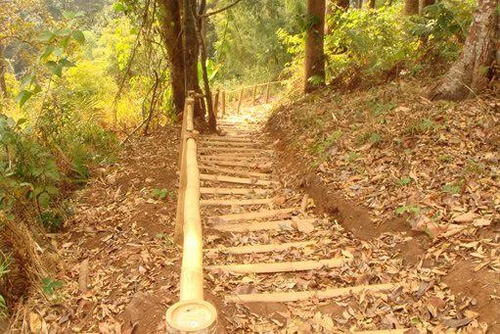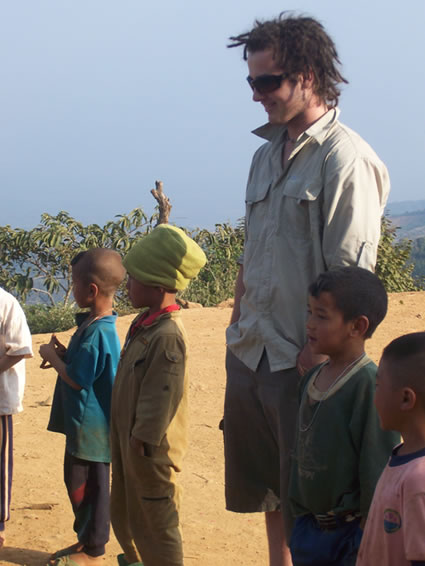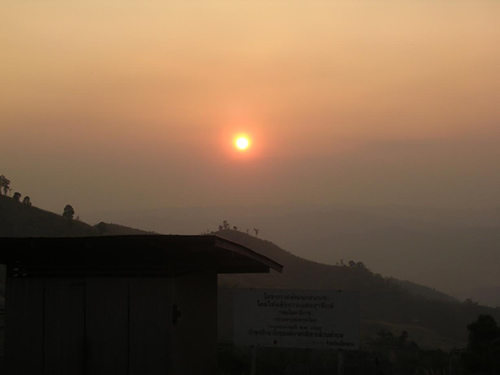Trekking as a Teen in Northern Thailand
A Tour to a Remote Hilltribe Region
Article and photos by Alana O'Connor

|
|
Steps along a trail in the Hilltribe region.
|
From the moment we arrive in an Akar village in northern Thailand’s Hilltribe area, it becomes exceedingly clear that hospitality is disproportional to wealth.
The Hilltribes of Northern Thailand are comprised of seven major tribes: The Karen, Hmong, Yao, Lahu, Lawa, Liso, and Akah. The descendants of the Hilltribe people migrated to the area from southern China approximately 100 years ago, and their way of life has mostly stayed the same despite a recent influx of tourism. The Hilltribe people are proud of their Chinese heritage and their Thai nationality. Consequently, in school, the children learn in Thai in the morning and Chinese in the afternoon.
Our tour with Intrepid begins with a night in Chiang Rai to organize trekking equipment and to visit a restaurant and information center called "The Cabbage and Condom." As expected, the guides quickly explained the bizarre restaurant name. The Population and Community Development Association (known in the area as the PDA) uses the restaurant as a not-for-profit venture, using the profits from the tourist trade to provide support and information to local communities, including the people from surrounding hill tribes.
The Liso and Akah people host small tours that trek through the area as part of Intrepid Tours. As inexperienced trekkers, we found that taking a guided tour that included small groups and local guides was the best way to experience the area's diverse culture.
Hiking uphill for hours at a time, thinking a few more trips to the gym before departure would have helped, sleeping on thin mats under mosquito nets, and using squat toilets are some physical adjustments that trekking in northern Thailand forces upon a Western tourist. Once you have come to terms with these changes, the rich culture and beauty of the Hilltribe people and their environment become more apparent. The laughter of the school children as we taught them the "Twinkle Twinkle Little Star" and the fresh sticky rice were even more appreciated, knowing that we had worked hard to get to the village in the first place.

|
|
The little boy wearing the green hat took a particular liking to my brother. When he found out it was my brother's birthday, he ran home after school and returned to our huts with a packet of wafer biscuits as a gift.
|
As we trekked, the red soil that clung to our skin and stained our clothes reminded us of the Australian outback. The pictures of English soccer stars on the host's walls sparked a comparison between our consumer-based Western culture and the simpler, more communal life of the Hilltribe people. The sight of children racing down the hill, seemingly escaping from school, brought back memories of our own school days, eagerly awaiting the end of the day.
An 18th birthday for a typical Australian would traditionally be spent in pubs and clubs or with family. Yet, my brother spent his night with the Akar people, who were our hosts. Through thoughtful gestures, such as a small boy who bought a packet of his favorite biscuits as a birthday gift to our group when he heard of the birthday, to the porters who carried fireworks up from Chiang Rai to contribute to a birthday celebration, the Akar people became not only our hosts for the night but our friends.
For our group, having no hot or running water was daunting. The trek probably would not have been contemplated or even possible without the help of a guided tour. The Intrepid tour company that led us provided local guides who eased our transition to these small, remote villages. We all discovered how narrow our tolerance was for missing the usual Western comforts; taking steps into this tradition and rich new world was a revelation.

|
|
Setting sun over the Hilltribe region in Northern Thailand.
|
For More Information
Intrepid Tours offers sustainable small group tours worldwide, inclusive of the one in which we participated.
|
|
